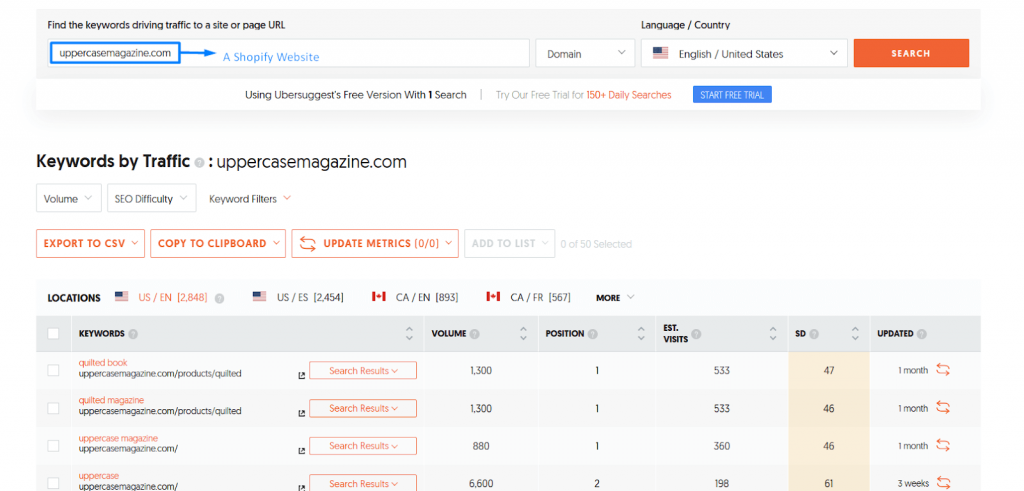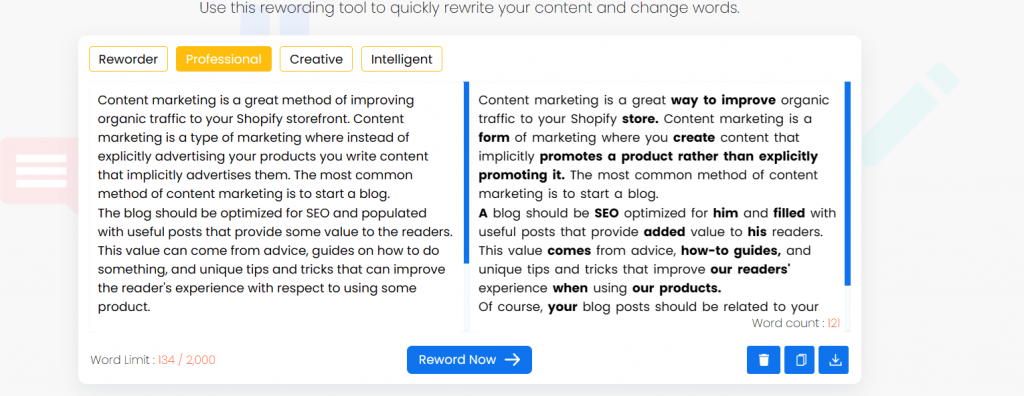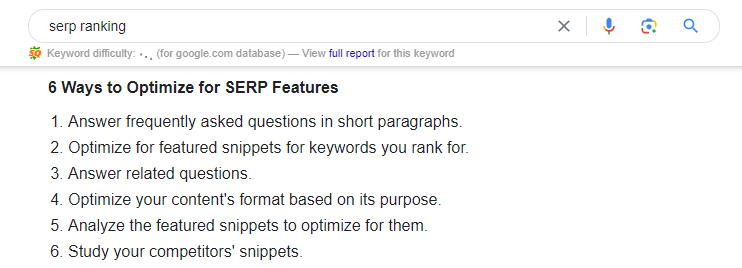Organic traffic is one of the most important sources of visitors to a website. For ecommerce stores, a huge benefit of getting more visitors is that it generates trust. Basically, people tend to believe in the judgment of search engines–who are the largest source of organic traffic on the internet.
If a website is found on the first page of a search engine like Google, chances are people will visit it rather than ignore it. This implicit trust is very beneficial for online stores because they have to do less to entice visitors to commit to a sale. That’s why generating organic traffic is important for the success of an online store.
In this article, we’ll focus on the tactics of generating traffic to your Shopify Store. These actionable tips will help you consistently get more traffic on your digital store.
How to divert more organic traffic to your Shopify store
Here are some tips for increasing the amount of traffic coming to your Shopify store.
Make your store SEO-friendly
SEO stands for search engine optimization. It’s an umbrella term for all kinds of activities that can make your website appear higher on search results. The higher your website appears, the more it’s considered trustworthy and useful for users.
So, there are many things to consider when it comes to SEO. Getting into it all would take too long. So, we’re just going to teach you about one major thing: using keywords.
Keywords are any phrase or word that people type into a search engine when they look for something. The keywords for your specific store will be similar to those of your competitors. For example, if your Shopify store is about kitchen appliances, some of the keywords relevant to it would be microwave oven, coffee machine, coffee grinder, electric toaster, and refrigerator. These would be just general keywords. They can become more specific as well, for example, a large waffle toaster, double toaster, and large sandwich maker.

These longer, more specific words are called long-tail keywords. By using different types of keywords on your web pages you tell search engines which kind of search queries your Shopify store should be shown under.
These keywords should also be used in the technical parts of your website such as in the header tags, alt tags, and any meta descriptions (only if you use those). By optimizing your Shopify store for keywords, you’ll be able to get people who search for those terms to find your store.
Use content marketing
Content marketing is a great method of improving organic traffic to your Shopify storefront. Content marketing is a type of marketing where instead of explicitly advertising your products you write content that implicitly advertises them. The most common method of content marketing is to start a blog.
The blog should be optimized for SEO and populated with useful posts that provide some value to the readers. This value can come from advice, guides on how to do something, and unique tips and tricks that can improve the reader’s experience with respect to using some product.
Of course, the blog posts should be related to your Shopify Store and the kinds of products you are selling on it. If they are too irrelevant, there won’t be any traffic coming from the blog to your store.
Here are a few ways of making your blog successful and generating more organic traffic:
- Write in a clear and readable manner. People don’t want to test their literary skills when reading a blog. They want some information quickly and easily. You can ensure that your blog posts are readable by using online tools such as a reworder. Reworder is a free tool that can manipulate content in various ways, one of which is paraphrasing the text to make it easier to read. You can see it in the following image.

- Make the blog easy to navigate and add internal links to your Shopify store on it. That way people will be able to find your store through your blog. You can do that by formatting the blog and using a convenient UI. Shopify stores come with a built-in blogging engine. It has many tools and accessories to make the reader’s experience a good one. Use those tools to your advantage. If you don’t know how to, there are many guides about them.
Use email marketing
Email marketing is a great tactic for gaining more organic traffic. Emails are widely considered a professional means of communication. They also have immense potential for customization. Audiences love it when they get customized marketing. Generic marketing methods and approaches have made people tired of them.
If an audience gets approached in those ways, they’ll become annoyed and refuse to humor the marketer. For example, if you cold-call someone about their car’s extended warranty, you would only hear a phone slam on the other end. To avoid this kind of response, you have to use personalized marketing.
As we discussed before, emails have vast potential for customization. As long as you’ve done your audience research properly, you can be sure that your sales revenue will increase by 20% through personalized emails. That’s because personalized emails have a higher open rate. The audience is more willing to read the email and act on it because it speaks to them in the way they like.
To personalize emails, and get more organic traffic to your Shopify store, here’s what you need to do:
- Research your audience and create buyer personas.
- Segment your email lists using these personas.
- Send emails tailored to each person according to their persona.
- Use the names of people in the Subject–it’s proven to improve the open rate.
- Add calls to action in your emails to motivate your audience to come to your Shopify store.
- Provide exclusive deals and discounts on products in your Shopify store.
- You can also divert people to your Shopify blog and get them to come to your store after reading your content.
- Format emails to be easily read on mobile devices. Most people read their emails through mobile, so making things easier for them is key.
By ensuring these things are present in your emails, you can dramatically improve the amount of organic traffic diverted to your Shopify store.
Make your Shopify store mobile friendly
Mobile friendliness is an SEO ranking factor. Google, the largest search engine, has adopted the policy of ranking websites based on their usefulness to the searcher. They grade that usefulness through a variety of secret methods that only they know. However, they do give out hints in their updates to let people know what to do and what not to do. Experts have used that information to piece together Google values customer experience a lot. For example, how easy it is to use a website counts towards its SERP ranking.

Enter mobile friendliness. According to an October 2023 report, approximately 55% of website traffic comes from mobile devices. That includes phones, tablets, and any other device that has a small form factor and can connect to the internet. If you don’t cater to this portion of your website traffic, you’re effectively turning away more than half of your organic traffic and worsening your SEO in the process.
Here’s how you can make your Shopify Store mobile-friendly:
- Use responsive design. Shopify offers a variety of fully responsive themes i.e., they’ll change their design and layout according to the screen resolution. Try out these themes and use the one that has the best mobile design.
- Add menus that are easy to navigate on mobile. The best example of this is the “Hamburger” menu, characterized by its three horizontal lines. Check out this image to understand what it looks like.

Keep the menus simple so that mobile users don’t have issues with navigating.
- Use fonts that are easy to read on small screens. Keeping things simple will improve the readability of your text and ensure that your audience doesn’t have any issues with reading your website material on a small screen.
- Use large input fields and touch-friendly buttons. You should use large input fields and touch-friendly buttons to ensure that mobile device users don’t have problems with incorrect tap registering.
- Optimize all images to fit a mobile screen and load quickly. Fast-loading images are essential for mobile friendliness.
These are some things that will boost the SEO ranking of your Shopify web store because they promote a great user experience. And the better the experience, the better the SERP ranking, which means more organic traffic for you.
Add and optimize images to your Shopify store
Images are very useful for getting more organic traffic to your Shopify store. But they need to be highly optimized to get the best of them. Images do two major things to get more traffic:
- First, they open up a whole avenue of traffic through image search.
- Second, the addition of optimized images makes your store’s SERP ranking higher.
We talked a bit about optimizing images for mobile friendliness and quick loading. Now we’ll talk about how that’s actually done. Image optimization refers to the art of reducing image size without sacrificing too much quality.
The goal is to find the point where the image size is the smallest while still maintaining a high image quality. This is done in various ways. Some of them are listed below.
- Compression of image files. There are multiple methods of file compression, but they can be divided into two types: lossy and lossless. In lossy compression, the file size is reduced by removing some image data. This results in a very small image size, but the quality suffers as well.
The second type i.e., lossless compression doesn’t discard image data, it only removes unnecessary data from the image file. It reduces the size, but not by a lot, however, it doesn’t sacrifice the image quality.
- Image resizing. Another method of reducing file size is to reduce the number of pixels by resizing. The fewer pixels there are, the smaller the image file size will be. You can use resizing to make a larger image fit your website. Just make sure that your image resolution fits the width and height you need because otherwise, it needs to be scaled using HTML and CSS. That results in longer load times and may turn away users from your site.
- File formatting. There are several file formats for saving image files. Some common and popular ones are called: JPEG (Joint Photographic Experts Group), PNG (Portable Networks Graphics), and GIF (Graphics Interchange Format). Out of the three, JPEG has the smallest size while still maintaining quality. So, try and use JPEG images more often to save on file size and improve loading times.
As for image search, most search engines have some method of searching with images. Google has an “Images” tab that shows pictures related to your query. To make sure your Shopify store images show up in the right searches, you’ll need to do the following:
- Name your images with descriptive names rather than generic ones. Descriptive names with some keywords in them help images perform much better on the SERPs.
- Add meaningful alt text to your images. Alt text helps the visually impaired get a better idea of what is shown in the image (i.e. a better user experience). It also serves as a text description for search engines.
- Add image title attributes. These provide context and help search engines understand the image’s content and its purpose.
When all is said and done, these images on your Shopify store will show up near the top in the SERPs and divert more organic traffic to the store.
Conclusion
In this article, we discussed five ways of getting more organic traffic to your Shopify store. We saw that you can optimize your store for SEO so that it shows up higher in the SERPs. We also learned that content marketing can help generate organic traffic. Some personalized email marketing can also work wonders. Making the store mobile-friendly and adding optimized images can also help improve its SEO. Another observation was that anything that can improve user experience helps improve SEO. By no means this is an exhaustive list, it’s actually quite small. But these five methods are the most fundamental, and getting them right will help you the most.

%20(1).png)





